The bathroom door is locked. The fan is humming. You are holding your breath while staring at a small plastic window. It is a moment of suspended time that millions of women experience every year. You are looking for a clear answer. You want a definite yes or a definite no. Instead you see a shadow. It is barely there. You find yourself tilting the stick under the light. You squint. You ask yourself if your eyes are playing tricks on you.
Table of Contents
This is the “squinter.” It is a phenomenon that brings hope and anxiety in equal measure. Modern home pregnancy tests are incredibly sensitive. They can detect pregnancy days before a missed period. However this sensitivity comes with a drawback. It makes the distinction between a true positive result and a mechanical error much harder to see.
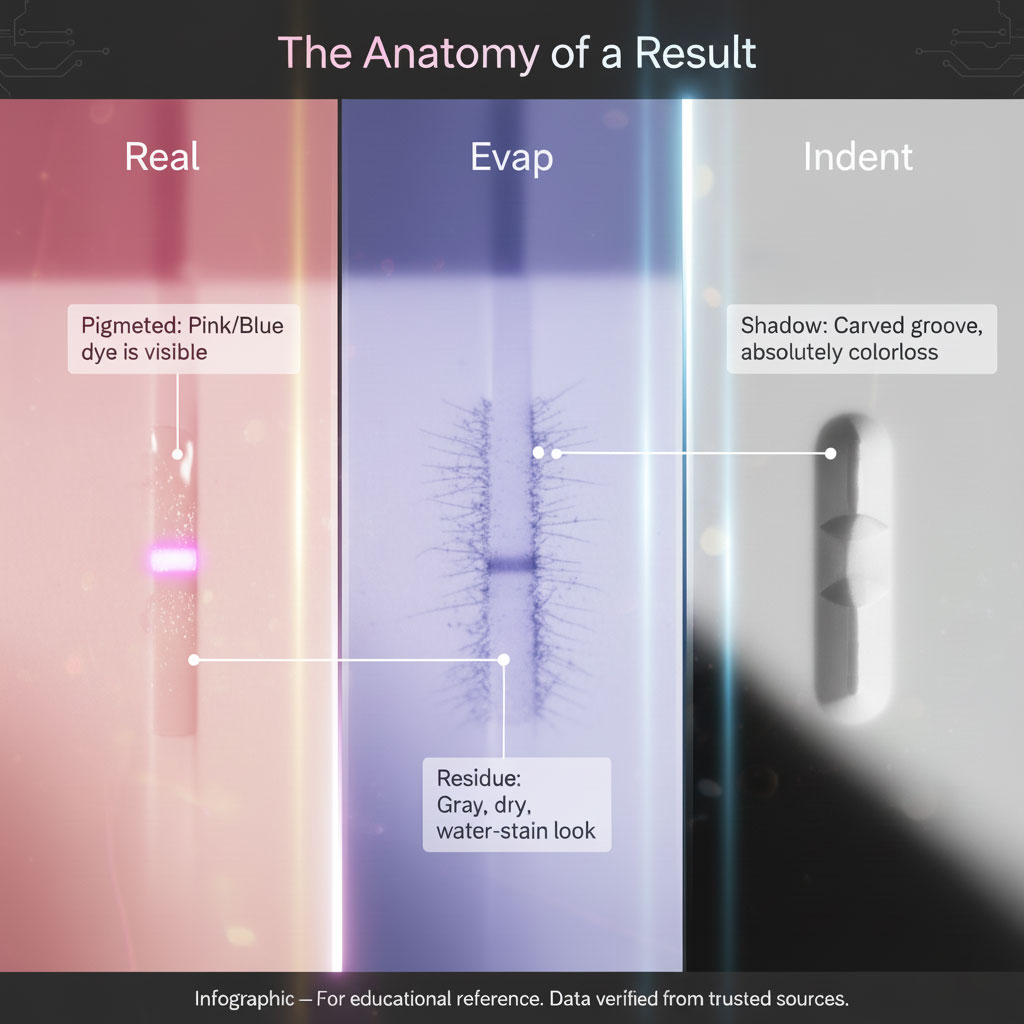
The difference between a life-changing positive result and a misleading evaporation line often comes down to minute details. You must look at color. You must look at timing. You must look at the width of the line. Understanding these nuances is critical. A false interpretation can lead to unnecessary heartbreak or confusion. This guide will walk you through every visual and biological detail to help you read your result with confidence.
Quick Answer: Is It Positive?
A faint positive line contains distinct pigment. It will be pink or blue depending on the dye used in the test. It appears within the test’s specific reading window which is usually 3 to 5 minutes. It indicates the presence of hCG.
An evaporation line is a colorless streak. It is often gray, white, or silver. It appears after the urine has dried which typically happens after the 10-minute mark. If the line disappears upon drying or lacks color when viewed in good light, it is likely an evaporation line. To confirm, retest in 48 hours to check for line darkening.
The Biology of the Line: What Are You Actually Seeing?
To read a pregnancy test accurately, you must understand the mechanics inside that plastic casing. It is not magic. It is chemistry. Home pregnancy tests work via a process called Chromatographic Immunoassay. This technology is designed to detect Human Chorionic Gonadotropin (hCG).
This hormone is produced by the developing placenta shortly after implantation. Implantation usually happens between 6 and 12 days after ovulation. Once the embryo burrows into the uterine lining, hCG enters the bloodstream and eventually the urine. The test strip contains antibodies coated with a dye. When hCG binds to these antibodies, the dye is activated and a line appears.
Understanding hCG and the Antibody Strip
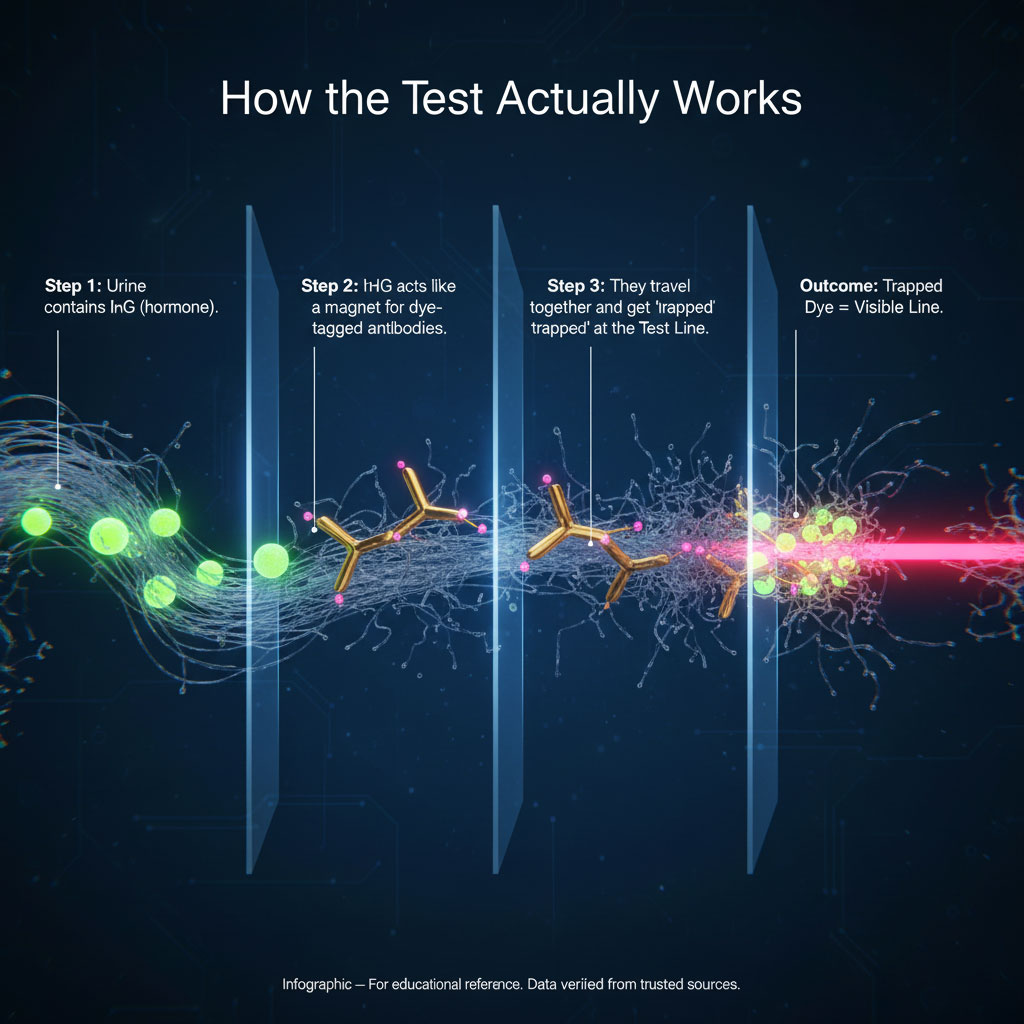
When urine travels up the absorbent tip, it passes through a reaction zone. This is often hidden under the plastic cap. This zone contains loose antibodies tagged with dye particles. These are usually gold nanoparticles for pink tests or latex particles for blue tests.
If hCG is present in your urine, it acts like a magnet. It latches onto the dye-tagged antibodies. They travel together up the strip to the test zone. Here they encounter a second set of antibodies. These are fixed in place. This is the “Test Line.”
The hCG molecule gets sandwiched between the moving dye-antibody and the fixed antibody. This concentration of dye creates the visible line. If there is no hCG, the dye flows past this zone without stopping. It settles only at the control line to show the test is working.
What Is a Faint Positive? (The “Squinter”)
A faint positive occurs when the test detects hCG, but the concentration is very low. This is common if you are testing early. For example, at 9 or 10 Days Past Ovulation (DPO).
At this stage, your hCG levels might be between 6 and 20 mIU/mL. This is enough to trap a small amount of dye. The result is a pale line. It might require bright lighting to see. However, it is a real positive pregnancy test result. It simply needs time to darken as the hormone levels rise. In a healthy pregnancy, hCG levels rise rapidly. A line that is faint today should be noticeably clearer in two days.
What Is an Evaporation Line? (The “Evap”)
An evaporation line is not a reaction to hormones. It is a residue mark. Urine is not just water. It contains salts, proteins, urea, and other compounds. As the moisture evaporates from the test strip, these compounds are left behind.
As the test dries, the antibody gel on the strip can shrink slightly. This creates a visible line where the chemical reagent is placed. An evaporation line typically appears colorless or gray. It is essentially a “water spot” on the test window. Think of it like a water ring left by a glass on a table. It marks the spot where the liquid was, but it is not a chemical reaction.
The “Indent Line” Phenomenon
If you frequent fertility forums, you have likely heard of the dreaded “indent line.” This is distinct from an evaporation line. An indent line is a manufacturing defect or feature of the test structure itself.
The test zone is essentially a groove pressed into the paper strip where the antibodies are applied. On some tests, this groove is visible even before you dip it. When urine flows over it, the liquid can pool in this groove briefly. It creates a shadow. This is notoriously common with certain batches of high-sensitivity tests. It looks like a white or silver line. It creates significant confusion for users hoping for a positive. The key difference is pigment. An indent has depth but no color.
Faint Line vs. Evaporation Line: The Visual Identification Guide

Distinguishing a faint positive from an evaporation line requires a keen eye. You need to look for specific characteristics. The most reliable factors are color, timing, and the width of the line. You have to be a bit of a detective.
The following breakdown will help you analyze your specific test result with precision.
The Color Test (Pink/Blue vs. Grey/White)
The most critical rule in pregnancy testing is that pigment equals pregnancy. A positive line must be the same color as the control dye. If you took a pink dye test, the faint line must be pink. It can be a barely-there pale pink. It can be a whisper of rose. But it cannot be gray.
An evaporation line is almost always colorless. It may look gray, white, or silver. It resembles a shadow rather than a dyed line. If you look at the line and cannot discern a specific color, it is likely negative. If you are unsure, take the test to a window with natural daylight. Artificial bathroom lighting can sometimes cast yellow shadows that make a gray line look slightly colored. Natural light is the truth-teller.
The 3-Minute Rule (Time is Everything)
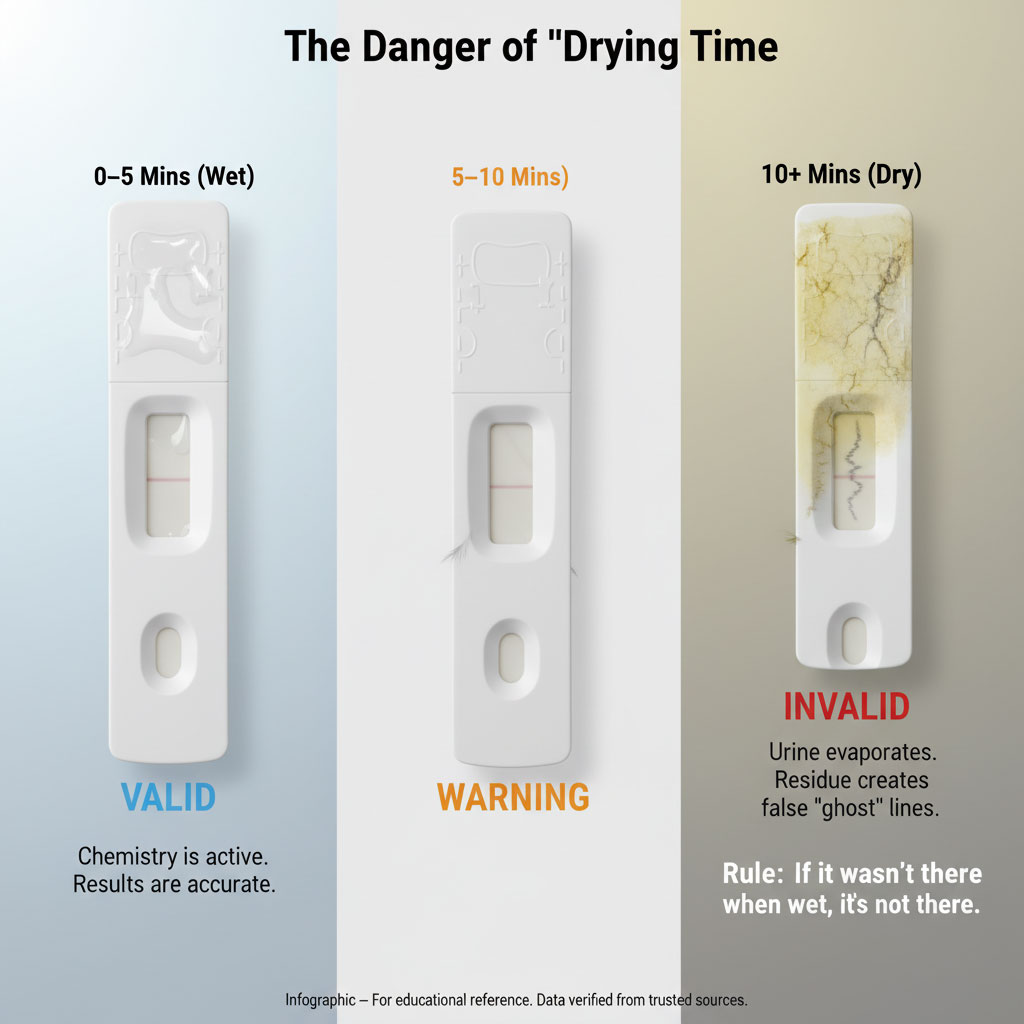
Every test manufacturer provides a specific “reading window.” This is usually between 3 and 5 minutes after taking the test. A true positive line will appear within this timeframe.
The chemical reaction happens while the strip is damp. Once the timeline passes, usually after the 10-minute mark, the test is invalid. A line that appears after 30 minutes or the next morning is almost certainly an evaporation line. Never dig a test out of the trash to check it later. The results change as they dry and become unreliable.
It is tempting to keep checking the test hoping a line will appear. However, staring at it for an hour allows the urine to dry and settle into the indentation lines. This creates false hope. Read it at 5 minutes. Then throw it away.
Line Width and Completeness
A valid positive result should be the full width of the test strip. It should look like a solid band. Even if it is faint, the width should match the control line.
Evaporation lines often appear as thin hairlines. They might look like a pencil stroke on just one side of the test window. Sometimes they appear as incomplete or splotchy lines. A “half line” or a thin hairline is usually an error or a dye run rather than a true positive. A true positive is a complete band across the test zone.
Pink Dye vs. Blue Dye Tests
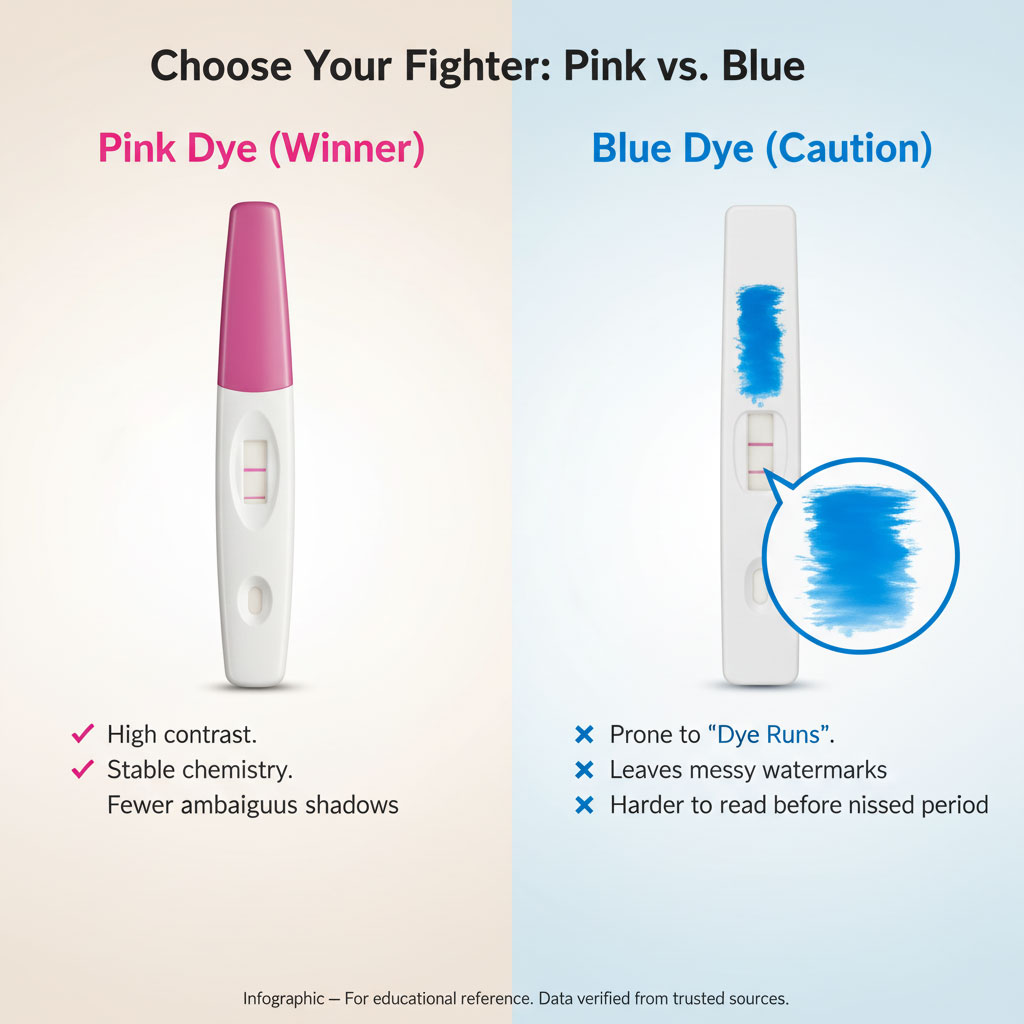
Seasoned testers usually prefer pink dye tests. Brands like First Response or Wondfo use pink dye. Pink dye is generally more stable. It is less likely to leave ambiguous shadows when it dries. The contrast between pink and the white background is also easier for the human eye to distinguish than blue on white.
Blue dye tests, such as Clearblue or Equate, are more prone to “dye runs.” Blue dye can smudge across the screen. It often leaves a thin blue hairline that looks positive but is actually a negative error. This leads to a higher rate of heartbreak for early testers. The blue dye can also leave a “watermark” that looks grey-blue, mimicking a positive. If you get a confusing result on a blue dye test, always verify with a pink one.
Visual Differences Checklist
| Feature | Real Faint Positive | Evaporation Line | Indent Line |
| Color | Pink, Red, or Blue (Matches Control) | Gray, White, or Colorless | Colorless / Shadow |
| Appearance Time | Within 3–5 minutes | After 10+ minutes (when dry) | Immediate (visible before dipping) |
| Line Width | Full width of the strip | Thin, hairline, or irregular | Standard width but “carved” in |
| Light Test | Blocks light (solid pigment) | Light passes through | Looks like a scratch/groove |
| Result of Retest | Gets darker in 48 hours | Varies or disappears | Stays the same (negative) |
Why Your Digital Test Says “Not Pregnant” (But Strip Is Positive)
It is a panic-inducing scenario. You see a faint line on a standard strip test. You feel a surge of excitement. You immediately take a digital test to confirm. The digital screen loads and then reads “Not Pregnant.” You are left confused and worried.
This discrepancy is rarely a sign of a false positive on the strip. Instead it is a matter of technology and sensitivity thresholds.
Understanding Sensitivity Thresholds
Pregnancy tests are rated by how much hCG they need to trigger a positive result. This is measured in milli-International Units per milliliter (mIU/mL).
- Ultra-Early Strips: Can detect hCG as low as 6.3 mIU/mL.
- Standard Strips: Usually detect 20–25 mIU/mL.
- Digital Tests: Often require 25–50 mIU/mL or higher.
The “Digital Gap”

If you are very early in pregnancy, your hCG might be sitting at 15 mIU/mL. This is enough to turn a sensitive pink dye test faintly positive. However it is below the “cutoff” for the digital reader. The digital chip sees the hormone but is programmed to say “Not Pregnant” because it hasn’t hit the confirmed threshold.
Digital tests contain an optical reader inside. They essentially “read” the line for you. If the line isn’t dark enough to meet the programmed standard, it defaults to negative. Do not assume the digital test is the final authority. It simply requires a higher hormone level. If you see a faint line on a strip but get a negative digital, wait 48 hours. Give your hCG time to rise above the digital threshold.
Common Digital Errors
Sometimes a digital test will show a “Book” symbol or a blank screen. This is an error message. It means the test was not performed correctly. Perhaps too much urine was applied, or the test was held at the wrong angle. It does not mean you are not pregnant. It means the test failed to run. You will need to purchase a new test.
Troubleshooting & “Hacks”: How to Be Sure
The “Wait and See” advice is medically sound but emotionally difficult. Marketers know that the “Two Week Wait” is agonizing. Users have developed several methods to inspect their tests. Some are helpful while others can ruin the test. Here is how to troubleshoot like a pro without invalidating your results.
The Flashlight Test (Inverting Colors)

This is a popular method in online communities. Take your phone flashlight and shine it through the back of the test strip. You are looking for density.
A true positive line has pigment. It effectively blocks light. It will look dark or glow with a specific color when backlit. An indent line is just a scratch in the plastic. The light will often shine right through it or make it disappear entirely. If the line vanishes under backlighting, it is likely an indent.
Photo Editing and “Tweaking”
Many women take photos of their tests and use editing apps to invert the colors or increase the contrast. This is called “tweaking.” While it can help you see where the line should be, be careful.
Ramping up the contrast can make invisible indent lines appear visible. Inverting the photo can make a gray evaporation line look glowing cyan (if the test is pink). Use these tools to see if a line exists, but do not rely on them to confirm color. Your naked eye in natural light is still the best tool.
The Water Test Myth
You may read advice to run water over an old pregnancy test to “clear the yellowing” and see the line better. Do not do this.
Adding water to a dried test reactivates the dye in unpredictable ways. It can flush the control line dye backward into the test window. This creates false positives. It can also wash away a very faint positive. Once a test is dry and outside the window, it should be discarded. No amount of manipulation can make an invalid test valid.
When to Retest (The 48-Hour Rule)
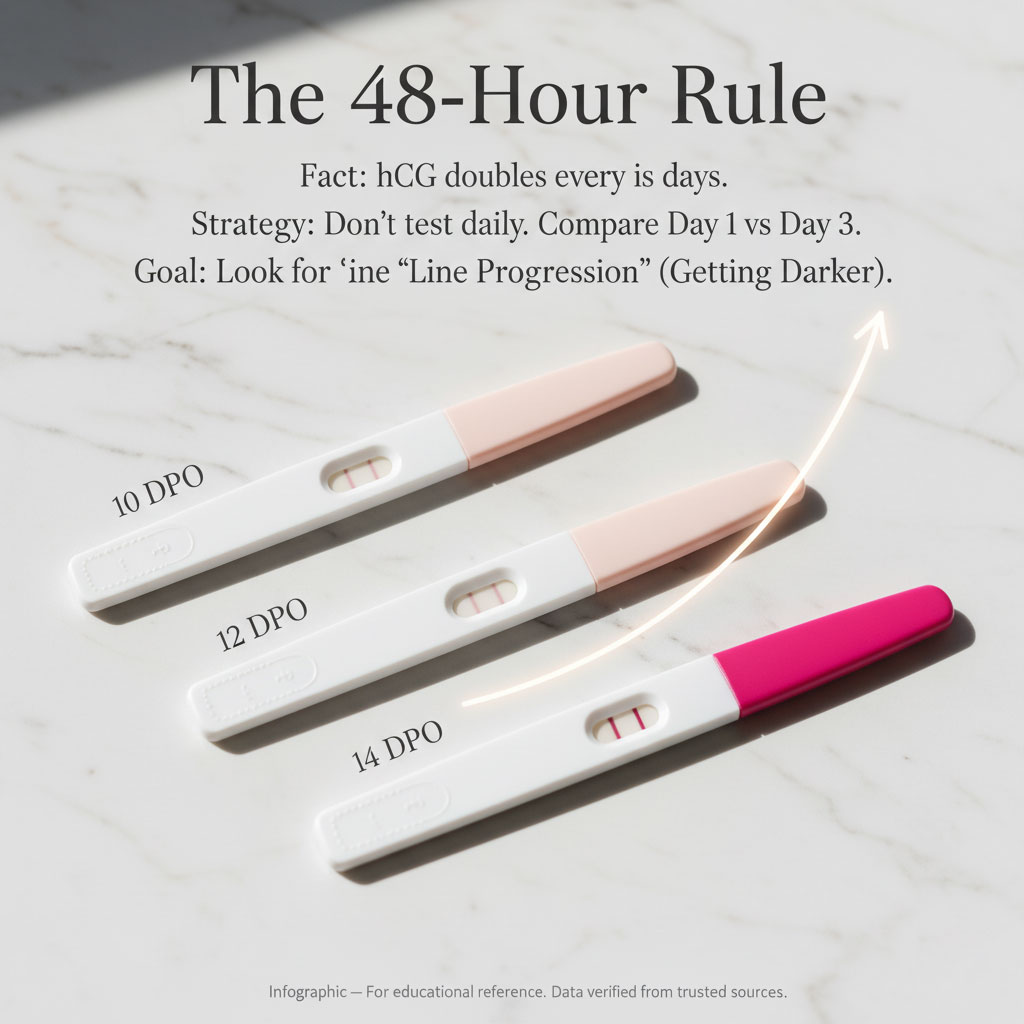
Human Chorionic Gonadotropin (hCG) typically doubles every 48 to 72 hours in a viable early pregnancy. Testing every few hours will not show a difference. It will only waste money.
If you have a faint line today, wait two days. Test again with First Morning Urine. This urine is the most concentrated after sleeping all night. Compare the new test to the old one. A real pregnancy will show line progression, meaning the second test should be noticeably darker than the first.
Top USA Pregnancy Test Brands Comparison
| Brand Name | Test Type | Sensitivity (mIU/mL) | Common Issues | Best For… |
| First Response Early Result (FRER) | Pink Dye / Manual | ~6.3 (High) | Bad Indent Lines (recent batches) | Earliest Detection (6 Days Sooner) |
| Clearblue Rapid Detection | Blue Dye / Manual | ~25 | Dye Runs / False Evap Lines | Testing after missed period |
| Clearblue Digital Ultra Early | Digital | ~10 | “Book Error” / Smart Countdown issues | Clarity (No line interpretation) |
| Wondfo / Easy@Home (Amazon Cheapies) | Pink Dye / Strip | ~25 | Slow progression | Bulk testing / Line progression tracking |
| Equate (Walmart Brand) | Blue Dye | ~25-50 | Thin Blue Hairlines (Evaps) | Budget testing |
False Positives vs. Chemical Pregnancies
Sometimes a faint line appears and is truly positive, but the pregnancy does not progress. Other times, medical factors mimic pregnancy hormones. Understanding these scenarios helps manage expectations and protects your emotional well-being.
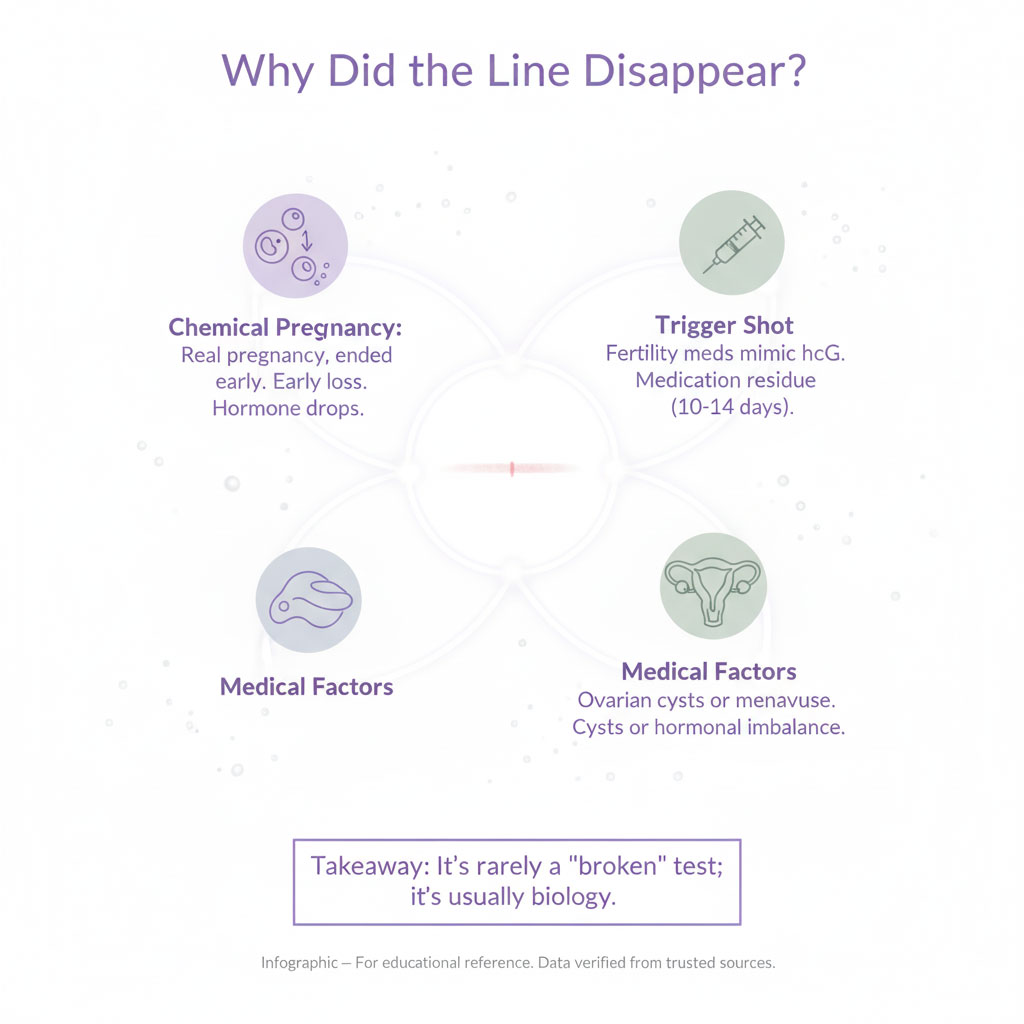
What If The Line Disappears?
You might get a faint positive on Monday and a negative result on Wednesday. This is usually not a case of an evaporation line “tricking” you initially. It is often a Chemical Pregnancy.
A chemical pregnancy is a very early miscarriage that occurs shortly after implantation. The egg implants and hCG is produced, causing a positive test. However, genetic abnormalities or other factors cause development to stop. Hormone levels drop. The line fades away. It is a heartbreakingly common event that accounts for 50% to 75% of all miscarriages. It is a real pregnancy that ended early. It is not a false positive.
Medical Causes for False Faint Lines
Certain medical conditions and treatments can cause a false positive.
- Fertility Medications: If you took a “trigger shot” (containing hCG) to induce ovulation, it can stay in your system for 10 to 14 days. Testing too early will show a positive result that is actually just the medication residue. To rule this out, you must “test out the trigger” by testing daily until the line disappears before trusting a positive.
- Ovarian Cysts: Certain cysts, specifically corpus luteum cysts, can produce hormones that mimic pregnancy.
- Menopause: Perimenopausal women can have elevated pituitary hCG levels. This can cause low-level positives on sensitive tests.
- Ectopic Pregnancy: While not a “false” positive, an ectopic pregnancy (where the egg implants outside the uterus) can sometimes cause hCG levels to rise slowly or fluctuate, leading to faint lines that don’t darken properly. This is a medical emergency. If you have faint lines accompanied by sharp one-sided pain, seek medical attention immediately.
The “Hook Effect” (Rare)
This is the opposite of a faint line caused by early testing. In rare cases of very advanced pregnancy (often with twins or molar pregnancies), hCG levels are so high that they overwhelm the test antibodies.
The antibodies get saturated and cannot bind properly to form the sandwich structure. This causes the test line to appear faint or lighter than the control line. This is called the Hook Effect. It typically only happens when you are significantly further along (5+ weeks). Diluting the urine with water and retesting can sometimes reveal a blazing dark line because it reduces the hCG concentration to a readable level.
The Psychology of Testing: “Line Eyes”
There is a term in the Trying To Conceive (TTC) community called “Line Eyes.” It describes the phenomenon where you stare at a negative test for so long that your brain begins to fill in the gap. You start to see a line that isn’t there because you want it to be there so badly.
This is a natural response to high-stakes testing. The desire for a baby can influence perception. This is why taking a photo and walking away is often better than staring at the stick. It is also why getting a second opinion from a partner or a friend can be helpful. If you have to manipulate the angle, the lighting, and the background just to catch a glimpse of a shadow, it is likely negative. A true positive, even a faint one, will eventually make itself known without special effects.
Summary & Key Takeaways
Navigating the world of faint lines and evaporation lines is stressful. The technology is advanced but not perfect. Your eyes are often looking for answers that simply require more time to become clear.
- Trust the Color: A faint positive must have pigment (pink or blue). Colorless lines are negative.
- Respect the Window: Results read after 10 minutes are invalid. Evaporation lines thrive on dried tests.
- Confirm with Progression: A single faint line is a “maybe.” A darker line 48 hours later is a “yes.”
- Be Wary of Blue Dye: Use pink dye tests for early detection to avoid ambiguous dye runs.
- Listen to Your Body: If you have symptoms and a faint line, trust your instincts but verify with science.
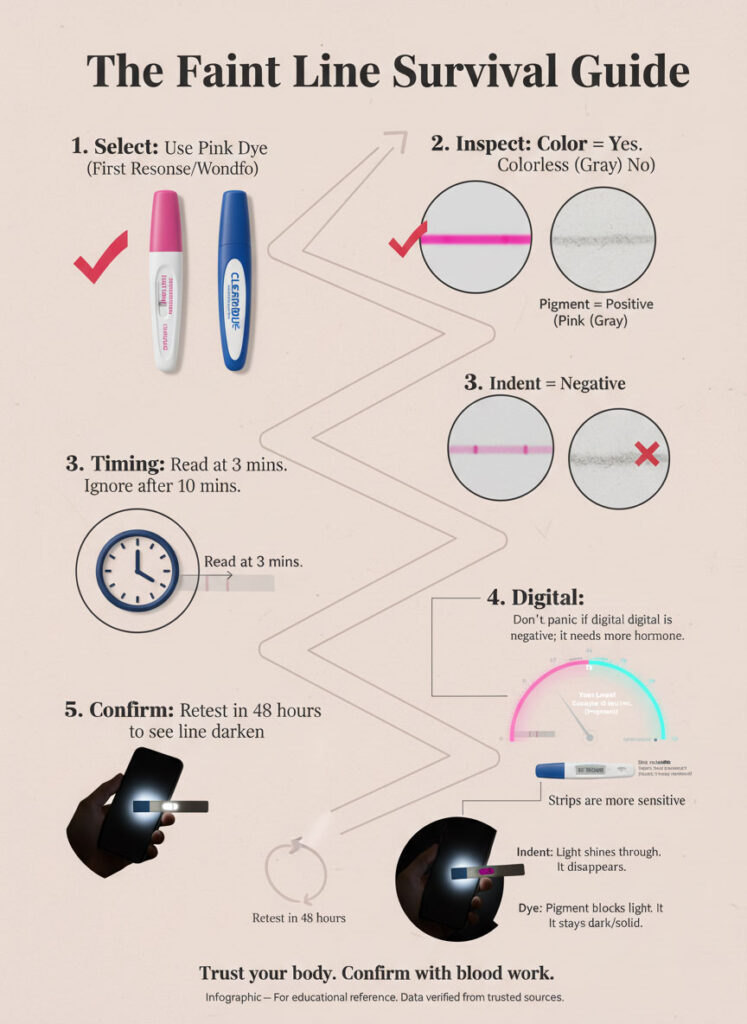
If you are unsure, the best course of action is patience. Wait two days and test again. If the line persists and darkens, contact your healthcare provider for a blood test (Beta hCG). This is the only way to be 100% certain of your pregnancy status. A blood test gives an exact number, removing the guesswork of faint lines and shadows.
Frequently Asked Questions (FAQs)
Can an evaporation line be pink?
No. An evaporation line is caused by dried urine residue and indentations. It typically appears colorless, grey, or white. If the line has distinct pink pigment, it is likely a faint positive result. However, a “dye run” (smear of pink) can sometimes look like a line. A true positive is a distinct, clean line with pink color that runs the full width of the test strip.
Why do I have a faint line but a negative digital test?
This happens because digital tests have a higher sensitivity threshold (usually 25–50 mIU/mL) compared to early result strip tests (6.3 mIU/mL). You are likely pregnant, but your hCG levels are not yet high enough for the digital display to register “Pregnant.” The strip test picks up the trace amount of hormone that the digital test ignores. Wait 48 hours and test again.
Is a faint line considered a positive result?
Yes. In the medical world, “a line is a line.” If there is a visible colored line within the reading window, it indicates the presence of hCG. The faintness is simply a reflection of the amount of hormone, not the validity of the result. A faint line at 10 DPO is just as positive as a dark line at 18 DPO.
Does a white line mean positive or negative?
A white line is a negative result. This is often an “indent line” or the antibody strip showing through the wet background. A positive result must be the color of the dye (pink or blue). A white or colorless line is not a sign of pregnancy. It is essentially a shadow where the dye should have been.
How long does it take for an evaporation line to appear?
Evaporation lines typically appear once the test begins to dry out. This usually happens after the 10-minute mark. This is why instructions explicitly state not to read the results after the testing window has closed. If a line appears the next morning, it is 100% an evaporation line.
Why did my positive pregnancy test fade after an hour?
Pregnancy tests are designed to be read while wet. As they dry, the background can yellow and the dye can fade or shift. This is especially common with blue dye tests. A result that fades or disappears after a few hours does not invalidate the original reading taken at the 3-minute mark. This is why taking a picture within the timeframe is recommended for your records.
Can drinking too much water cause a faint line?
Yes. If your urine is highly diluted, the concentration of hCG will be lower. This can make a positive line appear much fainter than expected. It is recommended to use “First Morning Urine” when testing early, as it is the most concentrated. If you test in the afternoon after drinking 40 ounces of water, you might get a false negative.
Are blue dye tests more likely to show evaporation lines?
Yes. Blue dye tests are notorious for having “dye runs” and more visible evaporation lines. The chemical composition of the blue dye is less stable than pink dye. This frequently creates thin blue hairlines or grey shadows that confuse users. Most experts recommend avoiding blue dye tests until after your missed period.
What does a “dent” in the pregnancy test mean?
A dent is an “indent line.” It is a small groove on the test strip where the antibodies are applied. When light hits this groove, it can create a shadow that looks like a line. It is negative. You can identify it by checking if the line has any color pigment. If it looks like a scratch in the plastic, it is an indent.
Should I look at my pregnancy test after 10 minutes?
No. Manufacturers advise discarding the test after the 10-minute window. Any changes to the display after this time, such as a new line appearing, are due to evaporation and are not valid results. Reading a test outside the window is the number one cause of false hope.
Can a UTI cause a faint positive pregnancy test?
Generally, no. A urinary tract infection (UTI) does not produce hCG. However, if there is significant blood or protein in the urine, it can sometimes interfere with the test strip background. This is rare. A faint line is almost always due to hCG or an evaporation error.
What is the best time of day to take a pregnancy test for faint lines?
The best time is immediately after waking up, using your first morning urine. This is when hCG is most concentrated because you haven’t been drinking water overnight. Testing in the afternoon with diluted urine can turn a faint positive into a false negative. If you must test later in the day, try to hold your urine for 3 to 4 hours and limit fluid intake.








